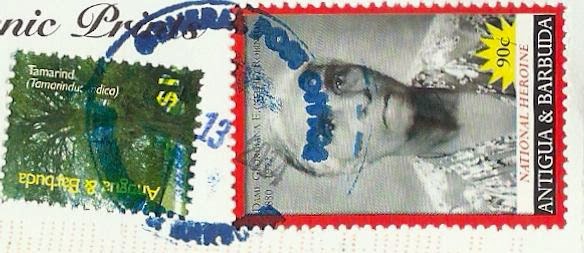The village of Soufriere, the premiere heritage site in St. Lucia.
Sent by John Williams from Burnley, England.
Dominating the mountainous landscape of St Lucia are the Pitons, two steep-sided volcanic spires rising side by side from the sea. Gros Piton (770 m) is 3 km in diameter at its base, and Petit Piton (743 m) is 1 km in diameter and linked to the former by the Piton Mitan ridge.
The Pitons are part of a volcanic complex, known to geologists as the Soufriere Volcanic Centre which is the remnant of one (or more) huge collapsed stratovolcano. The volcanic complex overlies a tectonic plate subduction (underthrusting) zone which stretches 700 km along Lesser Antilles, forming a volcanic arc.
The Pitons are the eroded cores of two lava domes formed on the flanks of the stratovolcano. Today they tower above a caldera-like formation, produced by a gigantic gravity slide or structural collapse which formed the Qualibou Depression, 7 km in diameter. Near the centre of the depression are the Sulphur Springs, an active, high temperature geothermal field with sulphurous fumaroles and hot springs. The Pitons occur with a variety of other volcanic features including cumulo-domes, explosion craters, pyroclastic deposits (pumice and ash) and lava flows. Collectively, these fully illustrate the volcanic history of an andesitic composite volcano associated with crustal plate subduction.
The Marine Management Area is a coastal strip 11 km long and about 1 km wide. It comprises a steeply sloping continental shelf with fringing and patch reefs, boulders and sandy plains. The coral reefs, which cover almost 60% of the marine area, are healthy and diverse. A survey to a depth of 20 m revealed 168 species of finfish, 60 species of cnidaria, including corals, molluscs, sponges, echinoderms, arthropods and annelid worms. Hawksbill turtles are seen inshore, and whale sharks and pilot whales offshore.
The dominant terrestrial vegetation is tropical moist forest grading to subtropical wet forest with small areas of dry forest near the coast and on steep slopes, and areas of wet elfin woodland on the summits. On the Pitons especially, small undisturbed natural forests remain, preserved by the steepness of the land. At least 148 plant species have been recorded on Gros Piton and 97 on Petit Piton. Among these are several endemic or rare plants, including eight rare species of tree. Some bird species, including 5 endemics, are known from Gros Piton, along with indigenous rodents, opossum, bats, reptiles and amphibians.
The area is a multiple-use management where agriculture, artisan fishing, human settlement (1,500 residents) and tourism (four large hotel developments) are allowed. (Source)



































